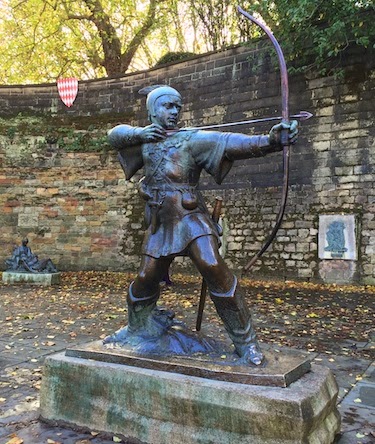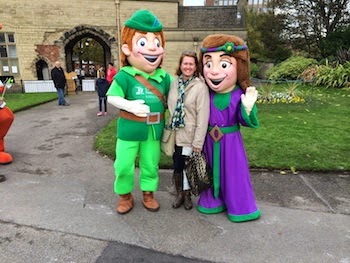 |
| Robin Hood Statue, Nottingham |
It’s doubtful that Nottinghamshire’s most famous resident ever actually lived, yet it’s equally certain that a number of people in medieval England bore the name “Robin Hood”. Let us explain (it’s why you read our travel blog, isn’t it?)
Ask pretty much anyone in the world for the name of a famous person from Nottinghamshire or its “ceremonial” county seat, the city of Nottingham, and they’re going to tell you Robin Hood. This county in the bullseye of England (sorry, couldn’t resist that reference) takes full advantage of their legendary first son with May Day celebrations, streets, hotels, squares and parks, restaurants, and (unsurprisingly) pubs named after him or any of his famous cohorts, like Little John, Friar Tuck, and the Maid Marian. The weekend after we arrived in Nottinghamshire, the city of Nottingham held a Robin Hood Pageant (blog coming soon), undoubtedly one of dozens of annual festivals and fairs associated with the legendary outlaw. All this Robin Hood mania seems put to good use: Nottingham is the 6th ranked tourist destination (by pound sterlings spent in 2011) in England.
The earliest written reference specifically identifying the character of Robin Hood is a ballad called “Robin Hood and the Monk” written in the mid 1400’s. The ballad likely captures a couple of centuries of storytelling by minstrels: references to “Robinhood”, “Robehood”, and “Robbehod” can be found in other works and the records of the English justice system, some as early as 1228. Once “Robin Hood and the Monk” was written, several more ballads appeared over the next century and the legendary character flourished and grew until the Victorian age when Howard Pyle wrote “The Merry Adventures of Robin Hood”. Then along came Errol Flynn, Kevin Costner, and Russel Crowe.
While some might point to those 13th century English justice system references as proof that Robin Hood was a real person, even if quite a bit different than the legend that evolved from his life, it’s more likely that “Robinhood” or “Robehood” referred to any unknown criminal or outlaw, much in the same way today’s police refer to an unidentified body as “John Doe”. Imagine a medieval English farmer who comes up a few sheep short in his herd. He goes to his local official–say, the Sheriff of Nottingham–to report the crime. Upon finding the farmer has no idea who has pilfered his sheep, the sheriff records the crime in his records as having been perpetrated by “Robinhood”.
That might seem a simplistic explanation, but the principle of Occam’s razor says the simplest solution is the most likely.
Regardless of whether Robin Hood actually lived, we can’t seem to get enough of the story. What’s not to love of a jolly, big-hearted, archery-ace vigilante who redistributes wealth and hangs out in the forest with his pals, including an inebriated man of God and a stick-wielding giant of a man named “Little”?
Q: who’s your favorite Robin Hood: Flynn, Costner, or Crowe?
 |
| Robin Hood, Lori, and Maid Marian |
A book lover’s footnote: new twists of the Robin Hood story continue to be written even now in the 21st century. One recent, very enjoyable, and sacrilegious version is the “King Raven” trilogy by Stephen Lawhead. In Lawhead’s version, Robin Hood is (gasp!) a Welshman, not English.






